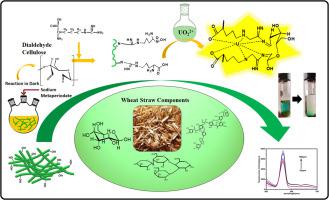Journal of Environmental Chemical Engineering ( IF 7.4 ) Pub Date : 2021-07-22 , DOI: 10.1016/j.jece.2021.106106 Preeti Tewatia 1 , Manpreet Kaur 1 , Sonal Singhal 2 , Anupama Kaushik 1, 3

|
Twin functional ecofriendly fluorescent probe and bioadsorbents were fabricated from wheat straw (WS) for detection and alleviation of hazardous uranyl ions from wastewater. Cellulose nanofibers (CFs) were isolated from WS using alkaline steam explosion and were converted into cellulose dialdehyde (DCF) via selective oxidation followed by conversion to Fluorescent Schiff base cellulose fibers (FSCF) by condensation with L-Arginine, a natural amino acid. Fourier transform infrared spectroscopy (FTIR), X-Ray Diffraction (XRD), field emission scanning electron microscopy (FESEM), energy dispersive X-ray spectrometer (EDX) and thermo-gravimetric analysis (TGA) established formation of Schiff base evenly on CFs yielding robust, crystalline and thermally stable fibrous bioadsorbents. FCSF exhibited affinity for uranyl ions in presence of competing ions and linear increase in fluorescent intensity with concentration at 561 nm when excited at 279 nm in DMF with a low limit of detection (LOD) of 8.09 μM and binding constant of 10 M-1m3. Under optimized conditions, adsorption studies revealed suitability of Pseudo second order kinetics with maximum adsorption capacity of 192.7 mg.g-1 and Langmuir isotherm confirming chemisorption of U (VI) ions. FSCF exhibited 97% adsorption efficiency after 5 cycles when tested for reusability. The results demonstrated potential application of FSCF for probing and removal of uranyl ions from wastewater.
中文翻译:

基于小麦秸秆纤维素的荧光探针和生物吸附剂,用于选择性和灵敏地减轻废水中的铀 (VI)
双功能环保荧光探针和生物吸附剂由小麦秸秆 (WS) 制成,用于检测和减轻废水中的有害铀酰离子。纤维素纳米纤维 (CFs) 使用碱性蒸汽爆炸从 WS 中分离出来,并通过选择性氧化转化为纤维素二醛 (DCF),然后通过与天然氨基酸 L-精氨酸缩合转化为荧光席夫碱纤维素纤维 (FSCF)。傅里叶变换红外光谱 (FTIR)、X 射线衍射 (XRD)、场发射扫描电子显微镜 (FESEM)、能量色散 X 射线光谱仪 (EDX) 和热重分析 (TGA) 在 CFs 上建立了席夫碱的均匀形成产生坚固、结晶和热稳定的纤维生物吸附剂。 nm 在 DMF 中以279 nm激发时,检测下限 (LOD) 为 8.09 μM,结合常数为 10 M -1 m 3。在优化条件下,吸附研究揭示了伪二级动力学的适用性,最大吸附容量为 192.7 mg.g -1和确认 U (VI) 离子化学吸附的朗缪尔等温线。当测试可重复使用性时,FSCF 在 5 个循环后表现出 97% 的吸附效率。结果证明了 FSCF 在探测和去除废水中铀酰离子方面的潜在应用。











































 京公网安备 11010802027423号
京公网安备 11010802027423号